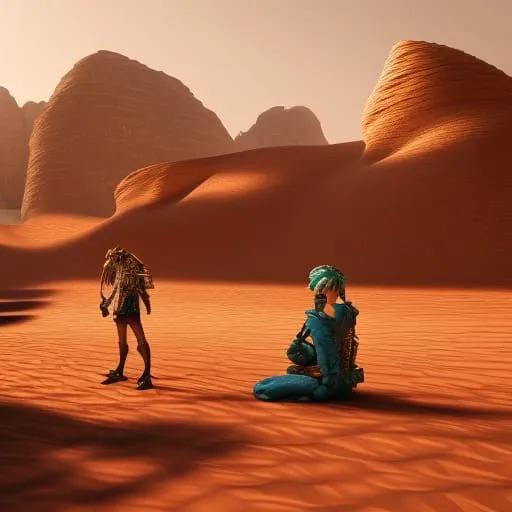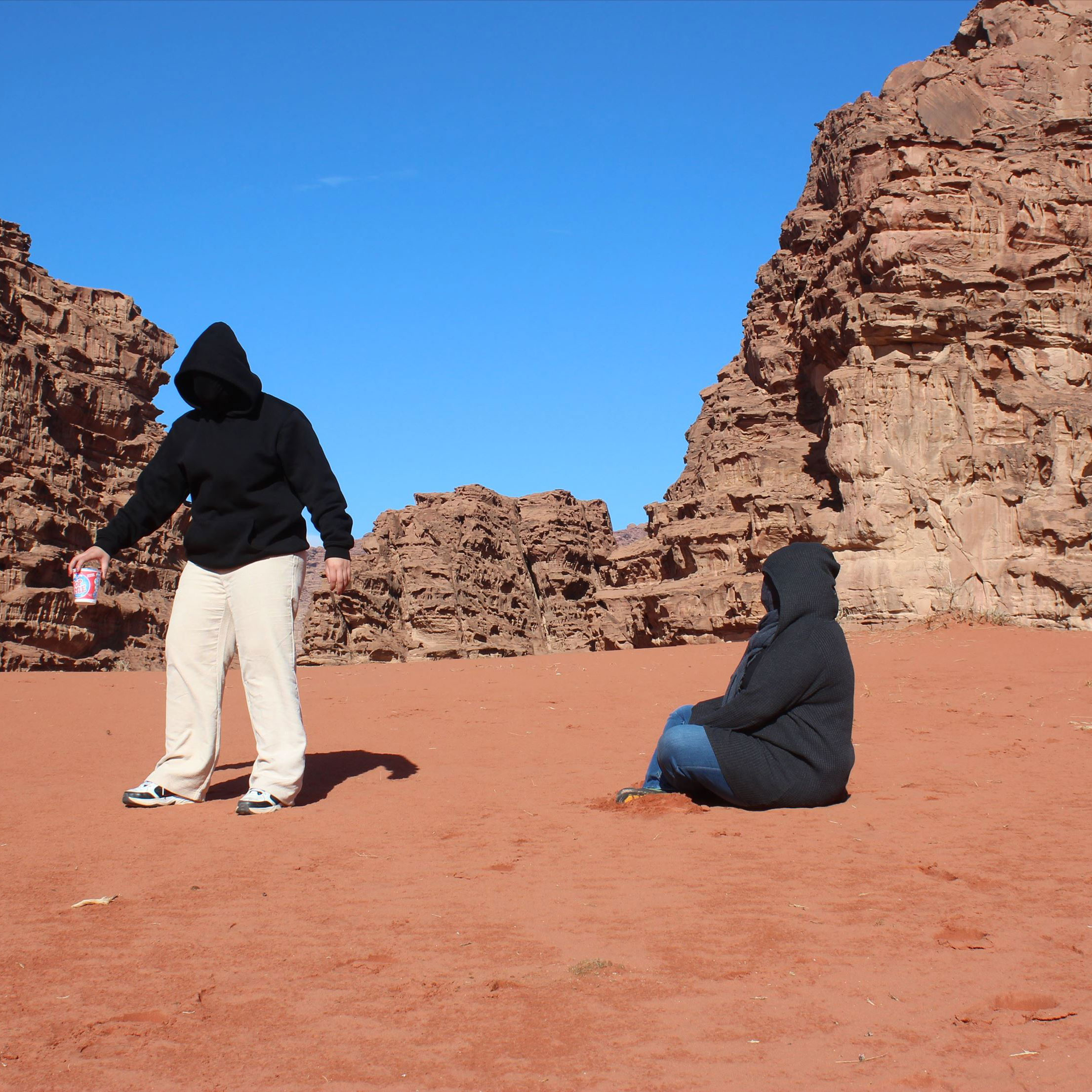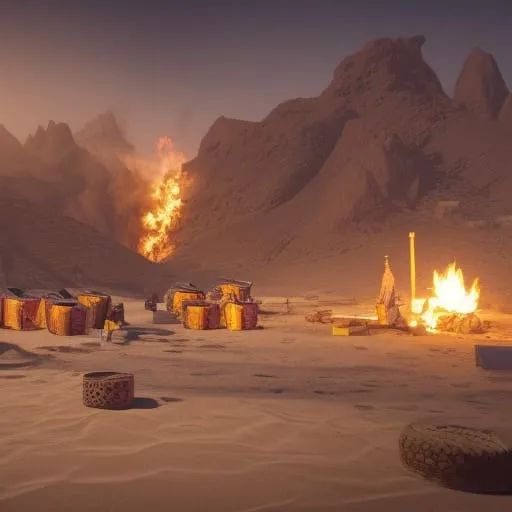للتحويل
to shift
مجموعة تقارب عن بعد
سلسلة أعمال تركيبية مؤقتة
2022
حتى الآن في برنامج ديمومة تحدينا أنفسنا كممارسين ثقافيين وكمجموعة فنية للتعامل مع عملية البحث والتواصل وتصميم الفعاليات من خلال مناهج مستدامة. في جزئية “ديمومة الصحراء” تعاملنا مع موضوع الاستدامة كفنانين، وقمنا بإنشاء رابط بين أسس تصميم الفعاليات الفنية والثقافية بشكل مستدام والممارسات الفنية المستدامة التي اقترحناها للفنانين الأفراد
كان الهدف هو اتخاذ خطوة إلى الأمام واستكشاف طرق للتفاعل الفني مع البيئة. من خلال سلسلة من التدخلات الخاصة بالموقع، قمنا باستكشاف المواقع الطبيعية التي تحتوي على علامات تدخل بشري والتي كان يجب أن تكون بشكلها الطبيعي بيئة خالية. كفنانين، واجهنا الأسئلة التالية: كيف يمكن للفنانين استكشاف علاقتهم بمحيطهم الطبيعي؟ ما الذي يعتبر طبيعياً في المقام الأول؟ كيف يختبر المرء الفن دون إحداث تأثير سلبي دائم على بيئة معينة؟
كان وادي رم أفضل مكان لاستكشاف هذه المفاهيم لكونه يضم مساحة شاسعة من الصحراء ذات نظام بيئي ومجموعة من القيم الخاصة بها. للأسف، تم تحويل تلك الخصائص لتحقيق مكاسب اقتصادية. عند النظر إليها من منظور ثقافي، لا يسع المرء إلا أن يفكر في المشاريع الثقافية أو الفنية الموجودة في الصحاري المجاورة، مثل العلا في المملكة العربية السعودية، أو فوريفر الآن في مصر. حيث تميل هذه المشاريع إلى استخدام الصحراء كخلفية جميلة لصور الناس على تطبيق انستاغرام بدلاً من إنشاء تفاعل مثير للتفكير مع ميزاتها المحددة. بينما تجذب تلك المشاريع الانتباه إلى المنطقة العربية، إلا أنها تفعل ذلك بطرق عدوانية
علاوة على ذلك، في المناطق الصحراوية الأردنية، هناك العديد من علامات التدخل الحضري من قبل المجتمعات المحلية، حيث تم تبني مناهج البناء والمعيشة المستعارة من المدينة داخل الصحراء. هذه الممارسات تؤدي حتما إلى تغيير الصحراء وبيئتها. ركزت مداخلاتنا الفنية على هجرة الأجسام الحضرية الغريبة عن الصحراء، وتفاعلت مع الهياكل والمواقع المختلفة الموجودة، وأثارت المزيد من الأسئلة
التأريض؟
هل بإمكاننا تسليط الضوء على ما هو غريب على البيئة باستخدام جسم غريب آخر لتحديد وجود بيئة أخرى؟
التبديل؟
هل بإمكاننا قبول وجود كائن غريب اذا تم دمجه مع محيطه؟
التكرار؟
هل بإمكاننا غض النظر على التدخل البشري من خلال محي وجوده؟
القطون؟
هل بإمكاننا إعادة تخيل واقع بديل تحمل فيه الهياكل الغريبة هدفاً؟
التحويل؟
ها بإمكاننا دمج الروايات الخيالية والفعلية معاً – أيهما يقود للآخر؟
the remote closeness collective
a series of ephemeral installations
2022
So far, in Shifting Grounds, we challenged ourselves as cultural practitioners and as a collective to tackle research, communication and event management with sustainable approaches. In to shift, the collective approached the theme as artists, creating a link between the event building we have experimented with, and the art practice rhetoric we have been proposing.
The objective was to take it a step further and explore ways of artistically interacting with ecology. Through a series of site-specific interventions, we explored locations that contained signs of human intrusion in what should have naturally been a bare environment. As artists, we faced the following questions: How can artists explore their relationship with their natural surroundings? What is considered to be natural in the first place? How does one experience art without creating an adverse lasting impact on a given environment?
What better place to explore these concepts than in Wadi Rum, a vast expanse of desert with its own set of values, unfortunately, diverted and transformed to achieve economic gain. When looking at it from a cultural perspective, one can’t help but consider cultural or artistic projects based in neighbouring deserts, such as Al Ula in Saudi Arabia, or Forever is Now in Egypt. These tend to use the desert as an instagrammable backdrop rather than create a thought-provoking interaction with its specific features. While these attract attention to the region, they do so in invasive manners.
Furthermore, in the Jordanian desert areas, there are many intrusive signs of urban intervention by the local communities, where they have adopted building and living approaches borrowed from the city. These practices inevitably transform the desert and its environment. Our interventions investigated the migration of urban objects foreign to the desert, interacted with different found structures and locations, and raised even more questions:
to ground?
to highlight what is foreign to an environment, using an invasive body to pinpoint the existence of another one?
to replace?
to accept the existence of an alien object to the point where one tries to integrate it into the landscape?
to reiterate?
to turn a blind eye on a human intervention, trying to delete its impact?
to inhabit?
to reimagine an alternate reality where the invasive structures bear a purpose?
to shift?
to fuse fictitious and actual narratives – which one leads the other?
تأريض
to ground
A short video that narrates the story of an alien structure in the middle of the deserted valley. An odd entity abandoned and discarded – but there to remain – is later claimed by another foreign body that is just passing by, and that seeks to highlight the absurdity of both their existence. The multiple laps act in domination and outshining, but the moving object is ephemeral and has to resort to leaving the site and abandoning the structure once again, left to its own devices, to live other lives or just perish alone.
تبديل
to replace
In this intervention, a discarded bed frame found in the desert, completely alien to its environment, is covered with flat rocks collected in its vicinity. The rocks have been shaven off the mountains by the elements, themselves alien to the sand dune beneath. The superimposed stones seek to merge the metal structure back into the landscape, diverting and canceling the intended use of the object.
تكرار
to reiterate
يحتمي البدو من أشعة الشمس الحارقة في زوايا الجبال من خلال بناء جدار واحد يغلق الأسطح المقعرة للجبل لانشاء غرفة. هذه الغرف ذات الجدران الواحدة هي مثال على هجرة المدينة ببطء إلى الموائل الطبيعية. على الرغم من وجود الكثير من التطفل في تقنية البناء هذه، إلا أنها لا تزال تحافظ على سلامة محيطها. هذا الجدار هو أحد الأمثلة على كيفية تعلم البشر بناء مأوى والتعايش مع الصحراء. في هذا العمل الرقمي يتم تركيب أنماط طبيعية من الأحجار المجاورة كمحاولة لتمويه التدخل البشري على الجبل
Bedouins shelter from the blazing sun in the corners of mountains by building a single wall that closes off the concave surfaces into a room. These single-walled rooms are one example of how cities have slowly migrated into natural habitats. Although there is much intrusion in this building technique, it still preserves the integrity of its surroundings. This wall is one example of how humans have learned to build shelter and coexist with the desert. Natural desert patterns are digitally and repeatedly applied to the shot of the single-walled shelter in this piece in an attempt to integrate it into the mountain.
القطون
to inhabit
تطفو طاولة في وسط هيكل معدني ينتمي إلى واحد من العديد من مواقع التخيم المهملة في وادي رم. يمكن ربط وجود هذه المواقع بجائحة الكورونا التي أغلقت العالم في عام 2020. وفقاً لهيئة السياحة الأردنية ، زار 5.3 مليون سائح الأردن بين عامي 2018 و 2019، مما تسبب في انتشار المعسكرات عبر الصحراء. تم التخلي عن ثلاثة أرباع هذه المواقع المبنية حديثاً في عام 2020، حيث انخفض عدد السائحين ذلك العام إلى 1.2 مليون
يخلق التركيب الخاص بالموقع واقعاً بديلاً غريباً حيث يتم منح هذه الهياكل حياة ثانية. يسلط التركيب الضوء على الفراغ الذي نشأ عندما تم إدخال الهياكل الأسمنتية والمعدنية بشكل دائم في المناظر الطبيعية الصحراوية. تسمح الجدران الفارغة للمشاهدين برؤية الهياكل الغير فعالة بسلاسة تقريباً، لكن تقف الطاولة البلاستيكية وبياضات الفوشيه (المستخرجة من جدار خيمة مكسور) داخلها لتسلط الضوء على الطبيعة التدخلية لهذه الآثار الصحراوية المعاصرة
A table floats in the middle of a metal structure in the desert, in equilibrium on the armature of a tent belonging to one of many discarded campsites in Wadi Rum. The presence of these sites can be linked to the covid19 pandemic that shut down the world in 2020. According to the Jordan Tourism Board, 5.3 million tourists visited Jordan in 2018 and 2019, causing a proliferation of campsites across the desert. Three-quarters of these newly built sites were abandoned in 2020, as the numbers of tourists plummeted to 1.2 million.
The site-specific installation creates an eerie alternate reality where these invasive built structures are given a second life. The installation highlights the void created when cement and metal structures were permanently introduced to the desert landscape and then left behind. The empty walls allow onlookers to see through the passive structures almost seamlessly, but the plastic table and its fuchsia linens (extracted from a broken tent wall) stand within to highlight the intrusive nature of these contemporary desert relics.
تحويل
to shift
Prompt: “Wadi rum thunder storm lost Jeep”
Prompt: “Wadi rum desert ramen noodle lunch”
Prompt: “Tea fire camp Bedouin desert”
يتم إنشاء ثلاثة أعمال فنية تم إنشاؤها بواسطة تكنولوجيا الذكاء الاصطناعي استجابةً لجمل قدمها فريق تقارب عن بعد لجهاز كمبيوتر. تم تغذية التكنولوجيا جمل مستوحاة من أحداث فعلية حدثت مع الفريق في الصحراء،وقام جهاز الكمبيوتر بإعادة إنشاء واقع خيالي جديد. بعدها أعاد الفريق إنشاء رؤى الكمبيوتر باستخدام المناظر الطبيعية الصحراوية كخلفية لها، مما سمح للتكنولوجيا بإملاء إنتاج الفنان
Three AI-generated artworks are created in response to prompts given by the Remote Closeness team to an art-generating software. Inspired by actual events experienced by the collective during their interventions in the desert, the three prompts allowed to create a new imaginary reality. The team then re-enacted the software’s creations using the desert landscape as its backdrop, allowing technology to dictate the artist’s production.
AI created using @NightCafeStudio







